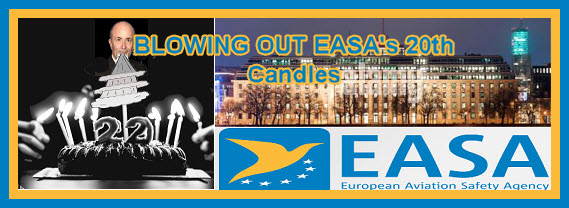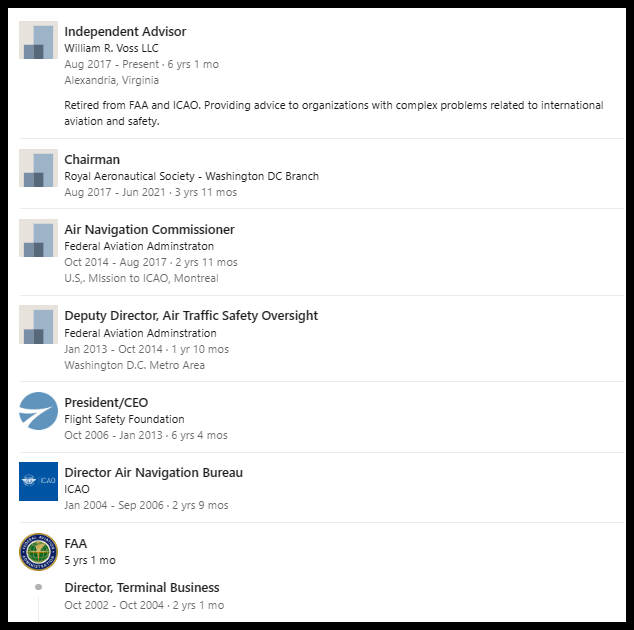Bill Voss, respected international aviation expert, blows out EASA’s 20th anniversary Candles

Below is a press release issued by the European Aviation Safety Agency (sometimes referred to as the European Union Aviation Safety Agency; herein after EASA) touting the now continental organization. It highlights its certification accomplishments (consolidating authority in Cologne from 28 now 27 +4 countries), increasing jurisdiction (now 840 employees in Europe and 5 international locations), UAM, greening initiatives and building technical competence. EASA has been the subject of 30 posts since 2020 here); so, an independent opinion was asked to blow the candles on the Cologne cake.
Thanks Bill Voss!!!
By Bill Voss[1]
William Voss is a well-known name in the aviation industry. He is an independent advisor on matters related to international aviation and safety. He served as the President and CEO of the Flight Safety Foundation (FSF)for 6 years. He was also the Director of the Air Navigation Bureau in the International Civil Aviation Organization (ICAO). He has been working as an Aviation Safety Technical Specialist at the Department of Transportation – Federal Aviation Administration for 35 years.
“I transitioned into the world of international aviation in late 2003 [see fn 1]. EASA and I sort of grew up together. Looking back at that time, the impact EASA has had on international aviation has been amazing. THE FAA WAS THE CLEAR REGULATORY LEADER AT THE TURN OF THE CENTURY. NOW I WOULD HAVE TO SAY THAT TITLE IS SHARED. EASA has done a remarkable job building a modern regulatory system that has been adopted widely across the world. Over the last 20 years many countries have quietly shifted their aviation regulatory systems from an FAR model to an EASA model. EASA continues to press forward in emerging areas such as AI certification and Cyber Security. A lot of the credit belongs to the 800+ professionals in Cologne and some very capable and ambitious leaders.
Global aviation safety is not a competition. When global leaders emerge and share the regulatory burden, there is no loser, just a winner – the traveling public. I think EASA and the FAA make each other better every day.
EASA’s success does not diminish the FAA’s central role. But during this year of FAA reauthorization, there are some things US policy makers should consider when reflecting upon EASA’s rapid rise.
- The leader of EASA does not have to drive regulatory policy and oversee the world’s largest ATC system at the same time.
- EASA does not even have to deal with day-to-day regulatory enforcement, that is done by the European Civil Aviation Authorities.
- Perhaps it makes some sense to separate policy and regulation from operations. That way urgent operational matters do not always win at the cost of important policy matters.
Another critical difference is STABILITY. I will leave you to consider these questions:
- How many Chief Executives has EASA had in the last 20 years?
- How many days has EASA been without a permanent leader in the last 20 years?
- How many thousands of hours have EASA leaders spent planning for government shutdowns?
EASA and the FAA have always made each other stronger, and will continue to do so, if policy members on both sides of the Atlantic take the time to consider the other’s strengths.
————————————————————————-
EASA: 20 years of safe aviation[2]
Topic type
This year (2023), EASA is celebrating its 20th anniversary. While the beginnings of the agency trace back to 2002, it only became fully operational in 2003. EASA built up from a loose cooperation between European “Joint Aviation Authorities (JAA)” into becoming the main player for aviation safety in Europe.
In these twenty years, the agency grew in size and responsibilities, all while keeping up with innovative technologies, international cooperation and, of course, environmental sustainability. In this article, we will guide you through some of the achievements from the past 20 years.
Certification highlights in the early years
Did you know that by the end of 2005, EASA had already issued over 20 000 certificates? One of them was for the iconic Airbus A380, the world’s largest passenger airliner still to this day. It received its “Type Certificate” (the certificate that testifies that this type of aircraft meets the safety requirements set by the regulator) from EASA and the Federal Aviation Administration (FAA) in a joint ceremony in 2006.
Another emblematic certification happened the following year. In 2007, EASA and the FAA certified the Rolls-Royce Trent 1000 TEN engine for the Boeing 787 family of aircraft.
Increasing responsibilities
With time, EASA’s responsibilities expanded. In 2008 and 2009 EASA’s domains of work started to include: Air Operations, Crew Licencing, Third Country Operators’ authorisation, Aerodromes and Air Traffic Management/Air Navigation Services.
In 2018, a new update to EASA’s “Basic Regulation” extended the Agency’s responsibilities to incorporate drones, urban air mobility and cybersecurity. This latest update also strengthened the Agency’s role in environmental protection, international cooperation, and research and development.
Advances in Urban Air Mobility
In 2019, EASA has proposed standards for the certification of aircraft capable of Vertical Take-Off and Landing (VTOL) and issued rules for new types of operations with Unmanned Aircraft Systems (UAS). Recently, in 2022, EASA published the first set of guidance for U-Space (in short, a set of solutions to manage unmanned aircraft traffic) and the design of vertiports, the ground infrastructure needed for the safe operation of Urban Air Mobility services such as air taxis.
Greener aviation and keeping pace with innovation
Aviation is always evolving. Just as in other industries, one of the greatest challenges of this time is to make it greener. EASA looks towards a future with more sustainable aviation shaped by new technologies like electric and hydrogen propulsion, Sustainable Aviation Fuels (SAF) and other innovative technologies to reduce the CO2 footprint.
Additionally, virtual/augmented reality and artificial intelligence (AI), further digitalisation, and new domains such as High-Altitude Operations are also in the radar of EASA.

View the full timeline with historic highlights
Our history & our people
Twenty years of operations is an achievement that does not happen magically. EASA counts on people from different fields of expertise to deliver the work entrusted to the Agency. In the video below, you can get to know some of the faces behind EASA’s vast portfolio of activities and what they are doing to make aviation safer and greener, in Europe and beyond.
Stay informed
Create an account and follow us on EASA Light to stay up to date with EASA’s activities.
Related Content
Timeline: EASA – Making aviation safer and greener for over 20 years
Drones & Vertical Take-Off and Landing – VTOLs
Research & Innovation and Artificial Intelligence (AI)
VTOL designs for Urban Air Mobility
Vertiports in the Urban Environment
==================================================
1)

2.
the website now reads “Making aviation safer and greened for over 20 years. ↑